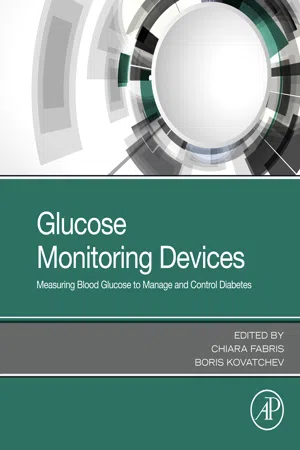Historical perspective and principles of blood glucose control
As Benedict developed a copper reagent for urine glucose, urine glucose testing has been the main method for diabetes monitoring for 50 years [1]. Later, a more convenient and specific “dip-and-read” urine glucose oxidase-based reagent strip (Clinistix) was introduced [2]. However, urine tests had several well-recognized limitations. High glucose levels were detected only when the renal threshold for glucose was exceeded over a period of several hours and the results were affected by fluid intake and urine concentration. Moreover, the test did not detect low glucose levels [3]. In the 1960s, first blood glucose (BG) test strips (Dextrostix) were developed. The exposure to blood resulted in a colorimetric reaction proportional to blood glucose concentration. The color change that occurred was compared to a color chart providing a semiquantitative assessment of blood glucose levels [4]. The first blood glucose meter, the Ames Reflectance Meter, was introduced in 1970. The meter exhibited quantitative blood glucose results based on Dextrostix test strips and reflectance photometry, thus eliminating visual reading errors. The results were displayed by a moving pointer on three analog scales [5]. The device was only available for testing in a doctor's office and hospital emergency departments [6]. Although the meter was heavy, expensive, and cumbersome to use, it ushered the development in an era of blood glucose monitoring systems. In 1972, more convenient Eyetone glucometer using Dextrostix test strips was developed, which was more precise, lighter, and easier to operate [7]. In 1974, Boehringer Mannheim launched Reflomat, a reflectance meter with modified reagent test strips (Reflotest), equipped to accept smaller volumes of blood, which was removed more easily and thus more suitable for at-home self-monitoring of blood glucose (SMBG) [6]. Dextrometer and Glucochek launched, in 1980, were the first glucometers with digital display [8]. Technological advances during 1980s made glucometers smaller and easier to use with built-in software to store and retrieve results [6]. The One Touch meter introduced in 1987 was regarded as the first second-generation blood glucose meter because it utilized an improved sampling procedure that eliminated blood removal step and the need for time reactions [9]. Toward the end of the 1980s, test strips changed dramatically when electrochemical principles to measure blood glucose were introduced. Furthermore, the introduction of electrochemical technology led to the development of the third generation of glucose monitoring systems [10]. The landmark in glucose self-monitoring was the release of the first electrochemical blood glucose monitor, ExacTech by Medisense, in 1987. The device used an enzyme electrode strip containing glucose oxidase and ferrocene as an electron transfer mediator. A current generated at the electrode was detected by an amperometric sensor [11].
Today, most glucometers are electrochemical, using commercial screen-printed strips based on the same principle. They require a smaller blood sample and provide results in a few seconds. Glucose oxidase and glucose dehydrogenase are two types of enzymes that have been used for commercial electrochemical blood glucose test strips. Test strips using glucose oxidase technology are susceptible to dissolved oxygen concentrations and can only be used with capillary blood in a normal range of oxygen levels. Glucose dehydrogenase-based test strips are not sensitive to oxygen [12]. However, coenzyme pyrroloquinoline quinone and glucose dehydrogenase containing test strips lack specificity as they cross-react with maltose, galactose, and xylose. Therefore they must not be used by patients on peritoneal dialysis [13]. The most common electrochemical detection methods for glucose measurement are amperometry and coulometry [12]. Coulometric strips have demonstrated to operate over the wider ranges of hematocrit values and with the minimized effect of temperature, high concentrations of paracetamol, uric acid, and vitamin C [14]. The performance of glucometers has further improved with simplified sampling and testing procedures to minimize user interaction errors. Meters using no-coding technology are precalibrated to report whole blood or plasma equivalent results [15]. Most current meters are plasma calibrated and automatically convert results into plasma equivalent results [16]. Modern electrochemical blood glucose test strips use the capillary gap to automatically draw blood into the test surface, which requires only a small volume of blood (just about 0.3 μL) and has automatic...
